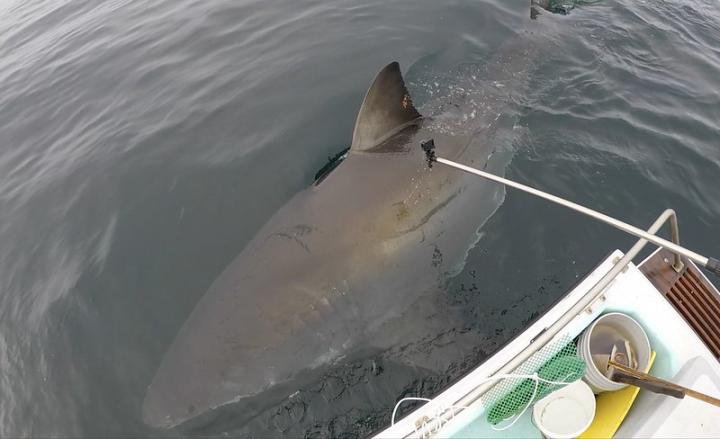
Credit: Scot Anderson
NEWPORT, Ore. – The population of white sharks that call the Central California coast their primary home is holding steady at about 300 animals and shows some signs of growth, a new long-term study of the species has shown.
Between 2011 and 2018, researchers were able to identify hundreds of individual adult and subadult white sharks, which are not fully mature but are old enough to prey on marine mammals. They used that information to develop estimates of the sharks’ abundance.
“The finding, a result of eight years of photographing and identifying individual sharks in the group, is an important indicator of the overall health of the marine environment in which the sharks live,” said Taylor Chapple of the Coastal Oregon Marine Experiment Station at Oregon State University’s Hatfield Marine Science Center and a co-author of the study.
White sharks, sometimes referred to as “great” white sharks, are apex predators, meaning they are the top animal of the food chain, preying on large marine mammals such as elephant seals, harbor seals and sea lions. As apex predators, they play an important role in the health of the marine ecosystem, said Chapple, who is an assistant professor in Department of Fisheries, Wildlife, and Conservation Sciences in OSU’s College of Agricultural Sciences.
“Robust populations of large predators are critical to the health of our coastal marine ecosystem,” said Chapple, a marine ecologist who specializes in the study of marine predators. “So our findings are not only good news for white sharks, but also for the rich waters just off our shores here.”
The findings were just published in the journal Biological Conservation. The study’s lead author is Paul Kanive of Montana State University. Additional co-authors are Jay Rotella of Montana State University; Scot Anderson of the Monterey Bay Aquarium; Timothy White and Barbara Block of Stanford University; and Salvador Jorgensen of University of California, Santa Cruz and the Monterey Bay Aquarium.
White sharks live in all of the world’s oceans. They can grow to 20 feet in length, weigh more than 2,000 pounds and live up to 70 years. They are listed as a vulnerable species due to threats such as fishing, because they can be caught up in commercial fishing gear, and poaching due to trade interest for their fins and teeth.
White sharks’ main aggregation in the California Current, the span of waters off the West Coast of North America, is off the coast of Central California in an area that stretches from Bodega Bay, north of San Francisco, south to Monterey Bay.
Through more than 20 years of study, researchers have learned this group of white sharks spends about half of the year in offshore waters of the northeast Pacific about halfway between Hawaii and Baja, Mexico, and about half the year along the Pacific Coast. They may travel as far north as Washington and as far south as Mexico, but tend to aggregate around islands and shores off the central California coast and Guadalupe Island in Mexico.
Monitoring animal populations and determining trends is important to understanding the health of the population and making decisions about population management and protections. In 2011, Chapple, working with Jorgensen and Block, published the first estimate of population size for the California sharks. The new study provides a longer term of observation of the population’s size and growth trends.
From 2011 through 2018, researchers collected photographs from above the water and underwater video recordings of white sharks during peak periods of their residency in the fall and early winter in the waters off the California coast. The data was collected from more than 2,500 hours of observation at three sites: Southeast Farallon Island; Año Nuevo Island; and Tomales Point.
They lured white sharks to their research boat with a seal decoy and captured more than 1,500 photographs that they used to identify individual sharks, focusing on adults and subadults.
“Every white shark has a unique dorsal fin. It’s like a fingerprint or a bar code. It’s very distinct,” Chapple said. “We were able to identify every individual over that eight-year period. With that information, we were able to estimate the population as a whole and establish a trend over time.”
Researchers often can also use the underwater video to identify whether a shark is male or female. Following the same sharks year over year allows them to gain insight into the sharks’ age and survival differences between males and females. About half of the sharks they saw each year were sharks they had seen previously, and about half were new sightings.
Overall, the researchers found that the population of white sharks numbers about 300, and evidence suggests that the adult population showed a modest uptick in numbers, while the subadult population held steady over the course of the study. The findings applied to both male and female sharks, though the estimate of the adult female population showed only about 60 sharks in this region.
“That underscores the need for continued monitoring of white sharks, as there are relatively few reproductively active females supplying the population with additional sharks,” said Kanive, the study’s lead author.
“Losing just a few animals can be really critical to the larger population,” he said. “It’s important that we continue to protect them and their surroundings.”
The Marine Mammal Protection Act, which protects many of the prey that are critical to white sharks’ survival, and restrictions on the use of gillnets in the California coastal region are likely factors helping the white shark population, Chapple said. But once white sharks leave U.S. waters, they continue to face threats.
“We can provide as much protection as possible while they are in coastal waters, but these sharks are highly migratory animals,” he said. “It will take international cooperation, agreement and enforcement to protect them.”
###
The research was supported by Stanford University and the Monterey Bay Aquarium.
Media Contact
Taylor Chapple
[email protected]
Original Source
https:/
Related Journal Article
http://dx.




